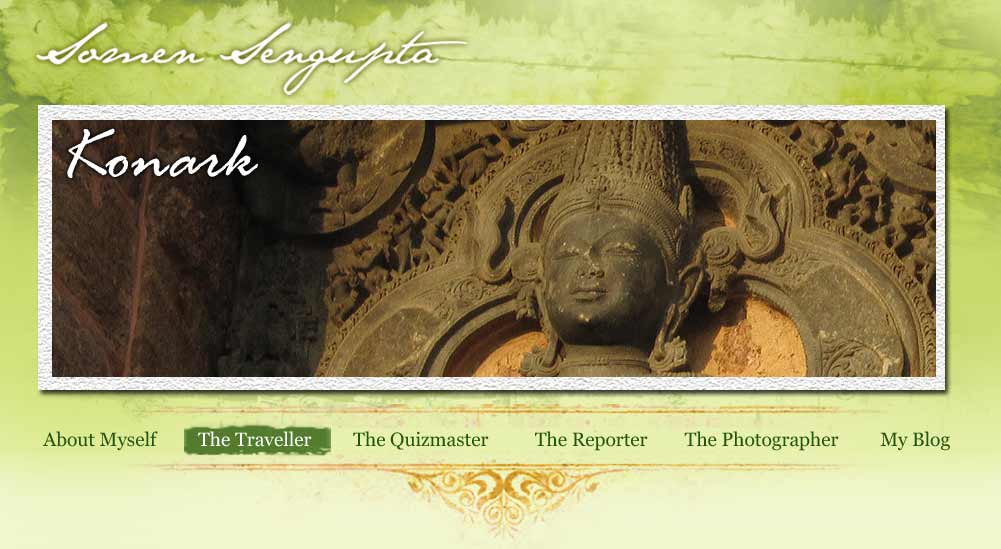|
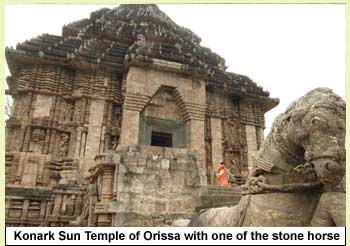 Odisha's Konark temple may not be even the shadow of what it actually was when it was constructed during the 13th century, but it still is a work where the ‘language of stone surpasses the language of man', writes Somen Sengupta Odisha's Konark temple may not be even the shadow of what it actually was when it was constructed during the 13th century, but it still is a work where the ‘language of stone surpasses the language of man', writes Somen Sengupta
Not even a drive of two hours from Bhubaneswar, the capital of Odisha, will take you to the ruins of a sun temple built in 1200 AD. Despite being in a state of dilapidation, it remains a magnum opus of architecture. More than hundred years ago when Rabindranath Tagore visited this site it was still lying in debris beneath wild bush and vegetation. Still its magical composition of stone made him so captivated that Tagore wrote: “Here the language of stone surpasses the language of man.”
Myth vs history
Yes we are talking about Konark, which is derived from two words: Kona means corner and Arka stands for Sun. So, the term literally means the corner of Sun beam.
Konark is more about myth than history. Mythology says that more than 5,000 years ago, Shambha was cursed by his father Krishna to suffer from leprosy. His crime was that he once entered into the pleasure chamber of his father while he was enjoying a bath with his consorts. With Shambha's entry, young consorts were attracted to him and they all rushed towards him, leaving his aged father alone. This made Krishna angry and he cursed his son. Shambha reached the banks of Chandrabhaga and entered into a 12-year-long penance in a jungle called Mitravana to please the Sun God. Satisfied by his hardship and sacrifice, the God set him free from the curse. A day after he was cured from leprosy, while taking bath in Chandrabhaga, Shambha found an image of the Sun God made by Vishwakarma. This inspired Shambha to set up what is today known as the Konark temple.
If Abul Fazl is to be believed, the temple was built by a king belonging to the Kesri dynasty in the ninth century. Most historical documents, however, support the case of Narshima Dev I of the Ganga dynasty who built this temple between 1243 and1260 AD as mark of his victory over Bengal. At least 12,000 craftsmen worked incessantly for 12 years to give the temple its shape. One Sibai Samantaray's name is recorded as a chief engineer of this architectural marvel. Another name, Bishu Maharana, too emerges as chief engineer.
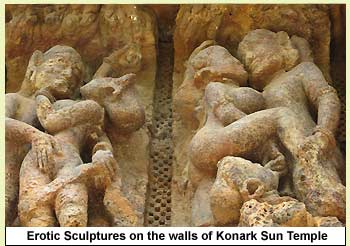 Even after 12 years of hard work when the temple work showed no sign of getting over, the king became agitated. He issued a stipulated period of time to complete it. History says that chief architect Bishu Maharana was in deep trouble because placing of the final copping stone atop of the temple was a gargantuan task. At that time his 12-year-old son Dharmapada, who was there by chance, offered a solution. No wonder, people began talking about Dharmapada for his superior engineering skills and Bishu Maharana's reputation came under cloud. Soon, the dead body of the young boy was found on the banks of Chandrabhaga. It is believed that he committed suicide by jumping from the top of the temple to save his father's reputation. Even after 12 years of hard work when the temple work showed no sign of getting over, the king became agitated. He issued a stipulated period of time to complete it. History says that chief architect Bishu Maharana was in deep trouble because placing of the final copping stone atop of the temple was a gargantuan task. At that time his 12-year-old son Dharmapada, who was there by chance, offered a solution. No wonder, people began talking about Dharmapada for his superior engineering skills and Bishu Maharana's reputation came under cloud. Soon, the dead body of the young boy was found on the banks of Chandrabhaga. It is believed that he committed suicide by jumping from the top of the temple to save his father's reputation.
The temple, however, was not destined to exist in all its grandeur for long. Soon it was lost into oblivion after a series of Muslim invasions ravaged the region. This remained the case till the beginning of the 20th century when archaeologists, backed by Lord Curzon, salvaged the temple.
Real Wonders
The present day Konark temple is not even a shadow of its past. The original temple was gigantic. Built in accordance with the Kalinga school of Architecture, it has three parts: The Natmandir or Nritya Mandir was the first complex; the Jagmohan was the middle complex; and, the Biman or garbhagriha was the place where the deity resided. The Jagmohan of Konark, which is the only signature left today, is 120 ft tall. The Biman, which no longer exists, was no less than 227 ft tall. It was taller than the illustrious Jagannath temple in Puri.
Yet Konark remains matchless. First, constructing a gargantuan temple in the shape of a colossal chariot with 24 wheels and pulled by seven horses is a breakthrough idea. We have seen many Sun temples in various places but nowhere such an epoch-making creativity was showcased.
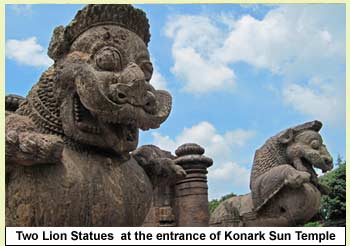 Again, the 24 wheels and seven horses were related to the Sun God. The seven horses are nothing but the seven days of a week while 24 wheels represent 24 hours of a day. Each of the stone wheels has one hub and eight spokes which are eight prahar of a single day. Even on each spoke various human activities are soulfully depicted — from showcasing a royal woman waking up from bed at the break of dawn to her aggressive sexual activity with her lover in the midnight. Again, the 24 wheels and seven horses were related to the Sun God. The seven horses are nothing but the seven days of a week while 24 wheels represent 24 hours of a day. Each of the stone wheels has one hub and eight spokes which are eight prahar of a single day. Even on each spoke various human activities are soulfully depicted — from showcasing a royal woman waking up from bed at the break of dawn to her aggressive sexual activity with her lover in the midnight.
There are nearly 2,000 figures of elephants decorating the entire Jagmohan. The incalculable numbers of humans, horses, elephants, birds and geometrical designs reflect the carnival of life. Once no less than 22 subsidiary temples existed around the main temple. Of these, only two are still remaining — Vaishnava temple and Mayadevi temple. Mayadevi is one of the wives of the Sun God as per Hindu mythology.
On the main entrance just before of the Natmandir exist two huge lion statues along with dead elephants. It symbolises the dominance of Hinduism over Buddhism as lion and elephants are the symbols of Hinduism and Buddhism respectively. The entrance gates of the Natmandir was built in such a way that the first ray of Sun at the break of dawn passes through its gate and hits a diamond placed in central complex. This way the idol placed there used to get illuminated every morning. The impact used to last for a few moments.
Lost and Found
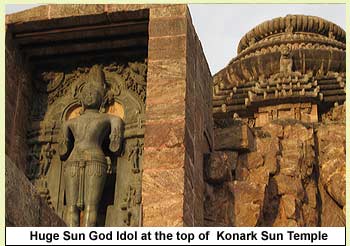 In 1806, the Marine Board first suggested salvaging this temple from complete destruction. The suggestion was not taken seriously by the East India Company considering huge cost involved in it. However, the Magistrate of Cuttack put a ban on the removal of stone from the site. But the loot continued. At that point of time the king of Khurda took away many slabs and statues from its wall to decorate his own palace. His laborers used to throw slabs from the top of the temple and many masterpieces were destroyed forever. The stupid king destroyed three gates of this temple. In 1806, the Marine Board first suggested salvaging this temple from complete destruction. The suggestion was not taken seriously by the East India Company considering huge cost involved in it. However, the Magistrate of Cuttack put a ban on the removal of stone from the site. But the loot continued. At that point of time the king of Khurda took away many slabs and statues from its wall to decorate his own palace. His laborers used to throw slabs from the top of the temple and many masterpieces were destroyed forever. The stupid king destroyed three gates of this temple.
Historical records tell us that the height of the main tower started reducing with each passing year. The height of the main tower recorded in 1837 by historian James Fergusson is lesser than the one recorded in 1825. It again got reduced by 1838 and a storm in 1848 did an immense harm to it. Except the middle part, known as Jagmohan, the entire temple with its 227-ft Biman was destroyed by 1869.
In 1901, the Bengal circle of the Archeological Survey of India (ASI) took a project to salvage Konark. It was none other than Lord Curzon who took personal initiative to save this wonder. By the end of 1905 Mukshashala and Natmandir were repaired. In 1906 plantation of trees towards the sea was completed to minimise the impact of sea wind. By removing sand the Mayadevi temple was unearthed in 1909. Till 1939 the restoration work was done by PWD under the supervision of ASI. From 1939 onwards ASI undertook complete responsibility of the temple.
The temple is now a part of UNESCO's world heritage site. Although ASI has done an outstanding job to protect this temple, nature is taking its toll on it. Sea winds are gradually causing erosion on its oxidised sandstones. So before it is too late let your eyes witness the wonder called Konark.
This article was published on 23rd September, 2012 in The Pioneer
Click here to view the original article |
